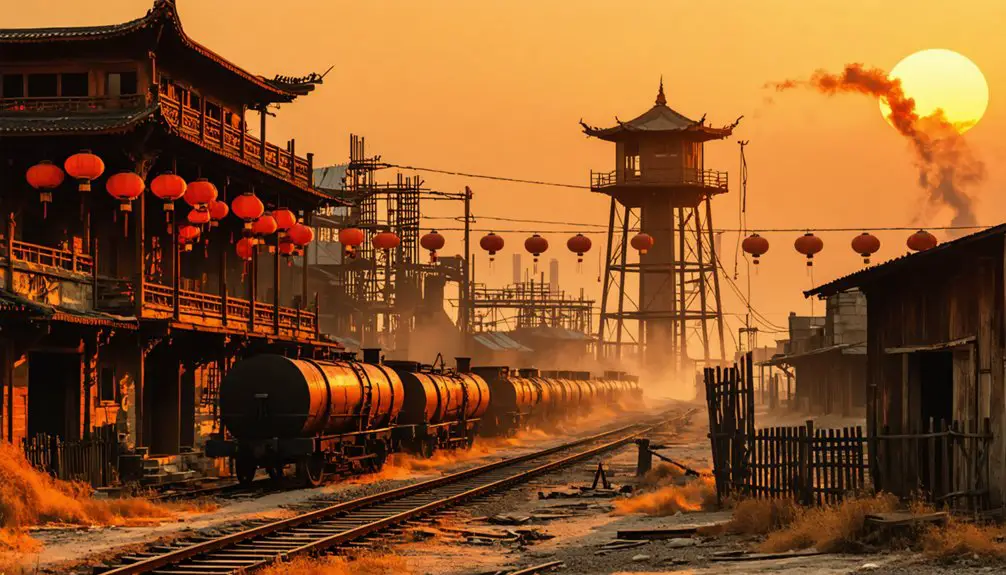You’ll discover the haunting remains of a Texas coal mining operation where 247 Chinese laborers arrived in January 1870 to build an 8-mile railroad and work the mines. They lived in company-controlled towns under strict surveillance, working dangerous underground shifts while facing ethnic segregation. The population grew to 710 by 1890, but economic shifts eventually led to the town’s abandonment. Today, ghostly tales and exposed gravesites tell a deeper story of this forgotten chapter in Texas history.
Key Takeaways
- A Texas ghost town emerged from a mining settlement where 247 Chinese laborers were hired in 1870 for railroad construction.
- Chinese workers lived in segregated, company-controlled housing and faced strict regulations while working in hazardous underground mining conditions.
- The site features historic gravesites of Chinese railroad workers and reported supernatural activity, including apparitions near burial grounds.
- No original buildings remain at the location, but the Texas Railroad Commission oversees preservation of the historic mining site.
- The ghost town’s legacy represents significant Chinese immigrant contributions to Texas history through mining and railroad development.
The Arrival of Chinese Miners in Texas
While the California Gold Rush of 1849 initially drew Chinese immigrants to America’s western shores, their presence in Texas emerged through different circumstances.
Unlike California’s gold-driven migration, Chinese immigrants found their way to Texas through distinct historical pathways and opportunities.
You’ll find that many Chinese workers first arrived in Texas after relocating from California, where they’d gained experience in railroad construction and mining. The devastating Taiping Rebellion (1850-1865) also pushed many to seek refuge and work opportunities in Texas.
A significant milestone in Chinese immigration to Texas occurred in January 1870, when 247 Chinese men were hired from San Francisco for railroad labor. The first major settlement was established in Robertson County, where records showed 72 Chinese residents by 1880.
By 1890, Texas saw its Chinese population grow to 710 residents, with significant concentrations developing in the western regions.
They preserved their cultural heritage by living in separate camps, establishing communities first in urban areas like El Paso and San Antonio before spreading to rural mining towns.
Despite facing lower wages and social tensions, they became integral to Texas’s industrial development.
Life in Company-Owned Mining Towns
In the company-owned mining town, you’d find your daily activities tightly controlled, from where you lived to what you could buy at the company store.
Your housing assignment depended on your ethnicity and job status, with Chinese workers typically segregated into separate areas from European immigrants and Anglo miners.
You couldn’t freely choose where to shop since the company store monopolized retail options, often using scrip instead of cash and charging inflated prices for basic necessities. The town’s main plaza and bandstand provided rare spaces for community gatherings and entertainment. Just like the former residents of Sweet Home, many workers were descendants of slaves who sought opportunities in these industrial communities.
Daily Life Under Control
Life in company-owned mining towns exemplified complete corporate control over workers’ daily existence. You’d find yourself under constant company surveillance, with agents monitoring your every move for signs of dissent or union activity.
Your workday consisted of grueling underground shifts in hazardous conditions, while rigid schedules maximized coal output. The workers faced especially harsh conditions extracting high sulfur coal that ultimately proved worthless for shipping. The company orchestrated every aspect of your social interactions to guarantee worker compliance. Armed guards patrolled the fenced perimeter to control access to the town.
- Your ethnic background was deliberately used against you, as companies recruited diverse groups to create divisions and prevent unified labor actions.
- Language barriers kept you isolated, with many workers speaking little to no English.
- You couldn’t freely save money or leave, as company scrip kept you economically bound.
- Your social activities, entertainment, and gatherings were strictly monitored and controlled to prevent organizing.
Housing and Store Rules
Moving into a company-owned mining town meant surrendering basic freedoms most Americans took for granted.
You’d find yourself living in a company-controlled house, with strict housing regulations dictating everything from who could visit to when you’d to be home. You’d couldn’t own your home or make improvements without company approval, and your residence assignment depended on your job status and ethnicity.
Similar to Texas Senate Bill 17’s property ownership restrictions, the mining companies controlled who could buy or own homes in their towns.
Residents typically paid between $1 to $2.50 per room in monthly rent, with their housing lease directly tied to continued employment.
You’d have no choice but to shop at the company store, where inflated store prices drained your wages – often paid in company scrip that was worthless anywhere else.
The store’s limited selection of basic supplies kept you dependent on the company’s terms. If you broke any rules or attempted to organize with fellow workers, you’d risk losing both your job and your home through immediate eviction.
Worker Rights Restrictions
Working in a company-owned mining town meant surrendering fundamental labor rights that other American workers increasingly gained during the industrial era.
You’d face systematic worker exploitation through restrictive employment contracts that banned protests and strikes. The company controlled every aspect of your working life through an intricate system of economic and social restrictions, while union suppression kept you from organizing for better conditions. Even if you lived 300 feet from mines, company rules still dictated every aspect of your daily existence.
- You couldn’t freely spend your wages since you were paid in company scrip, only valid at overpriced company stores.
- You’d risk immediate termination for attending labor meetings or speaking with union organizers.
- Company police monitored your movements and enforced curfews rather than protecting your rights.
- Your grievances went to company-controlled courts and arbitrators, virtually guaranteeing unfavorable outcomes.
Working Conditions Underground
Deep beneath the surface, Chinese coal miners endured brutal 12-hour shifts in conditions that challenged human endurance.
With minimal workplace safety measures, you’d find yourself maneuvering through dark tunnels without proper protective equipment, constantly at risk of cave-ins and explosions. The air you’d breathe was thick with coal dust and sulfur fumes, leading to severe respiratory problems and chronic illness. Japanese guards patrolled the perimeter to prevent workers from escaping the harsh conditions.
Miners crawled through pitch-black passages breathing toxic fumes, their lungs filling with coal dust while death lurked in every tunnel.
The health hazards were relentless – from the lack of clean water that spread typhoid and cholera, to the malnutrition that weakened your immune system.
You’d work continuously with few breaks, your body deteriorating from exhaustion and constant exposure to toxic environments. Without access to adequate medical care, diseases spread rapidly through the mining community, while company officials prioritized profit over your wellbeing.
Cultural Impact and Social Dynamics
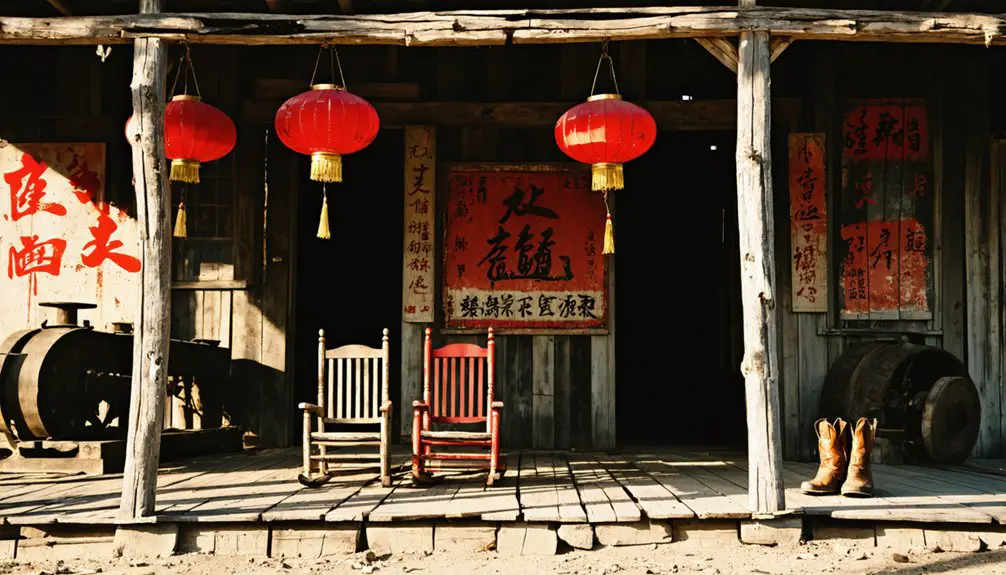
Beyond the physical hardships of mining life, Thurber’s social fabric emerged as a complex tapestry of diverse immigrant cultures. Under the tight control of Texas and Pacific Coal Company, workers from Italy, Hungary, Mexico, Poland, Ireland, and Russia built strong communities through cultural exchanges and shared experiences.
Despite company restrictions on unions and personal freedoms, these immigrant groups demonstrated remarkable community resilience, preserving their traditions through churches, schools, and social gatherings.
- Your ethnic heritage determined your place within Thurber’s strictly segregated neighborhoods.
- You’d find comfort in tight-knit cultural groups that shared language and customs.
- You couldn’t escape company oversight of daily life, from housing to entertainment.
- You’d witness how shared struggles fostered cooperation across ethnic lines, despite tensions.
The Rise and Fall of Thurber
You’ll discover Thurber’s remarkable transformation from a small mining operation into Texas’s largest bituminous coal town, housing up to 10,000 residents by 1920.
The Texas and Pacific Coal Company’s strict control over the town created a self-contained community with extensive infrastructure, including schools, churches, and the county’s only library.
The town’s fortunes were inextricably tied to coal mining, and when oil discoveries in nearby Ranger reduced coal demand, Thurber’s decline became inevitable.
Mining Town’s Glory Days
How did a small Texas coal mining operation transform into one of the state’s most prosperous company towns? In 1886, the Johnson brothers established a coal mine that would soon become Thurber, Texas.
While there’s no record of Chinese contributions or cultural exchange, the town drew immigrants from eighteen different nationalities, creating a diverse workforce that fueled its rapid growth.
- You’d find workers from Italy, Poland, and Mexico laboring alongside immigrants from Britain, Germany, and Russia.
- The company built an impressive 650-seat opera house, electric plant, and hotel to keep workers content.
- At its peak between 1918-1920, you’d see 8,000-10,000 residents bustling through the streets.
- Despite company attempts to control workers, labor unions maintained a strong presence from the beginning.
Company Control’s Fatal Impact
While Thurber’s prosperity drew thousands of workers seeking opportunity, the Texas and Pacific Coal Company‘s iron-fisted control ultimately sealed the town’s fate.
You’d find every aspect of life controlled by the company – from the houses you’d live in to the stores where you’d shop. They’d even fence off the town to keep outside influences away.
Despite attempts at labor solidarity through organizations like the Knights of Labor, the company crushed union activities and recruited diverse immigrant workers from 18 nationalities to maintain their power.
Community resilience emerged through shared struggles, but the company’s monopoly left workers with no economic alternatives.
When coal demand declined, Thurber’s fate was sealed. The town’s complete dependence on a single company proved to be its undoing, transforming a once-thriving community into a ghost town.
Architecture and Infrastructure
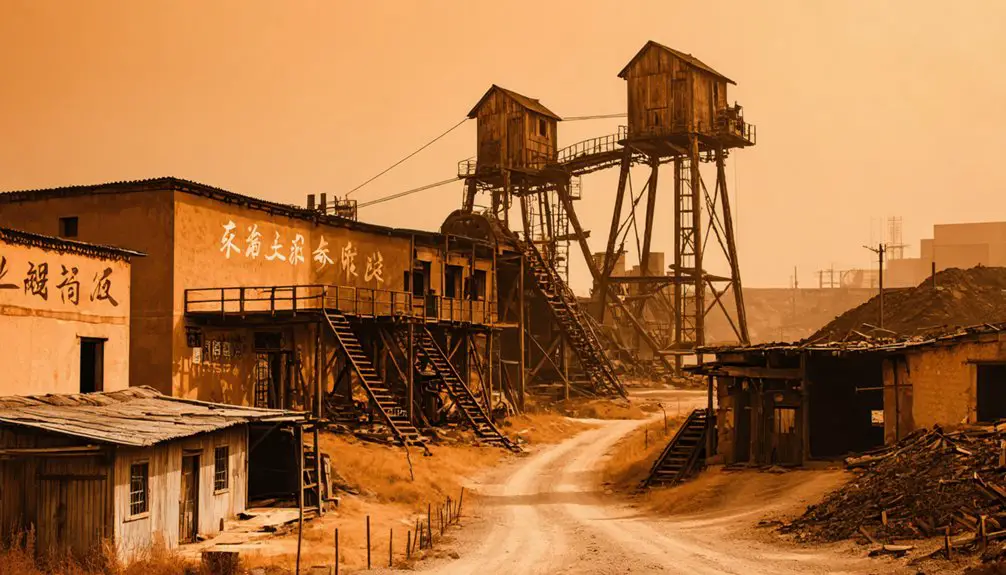
Despite its short-lived operations, the Chinese Coal Mine site near Van Horn, Texas once featured an ambitious 8-mile railroad infrastructure built by Chinese laborers in the late 1800s.
In West Texas, Chinese laborers constructed an impressive 8-mile railway system, destined to serve a coal mine’s brief existence.
Today, you’ll find little evidence of the site’s industrial past, as infrastructure decay has claimed nearly all physical structures. The rail line, built specifically for coal transport, operated just once before being abandoned due to the coal’s poor quality and high sulfur content.
- The gravesites of Chinese railroad workers remain as the most significant historical markers
- No original buildings or mining facilities survive at the location
- The site’s historical significance lives on through scattered fossil specimens
- You’ll need permission to explore, as the area sits on private land
Daily Life and Community Spirit
Life at the Chinese Coal Mine settlement revolved entirely around the grueling tasks of railroad construction and coal extraction, with Chinese laborers forming the core of this temporary workforce in the late 1800s.
You’d find no schools, churches, or formal gathering places in this transient community. Workers found solidarity through their shared labor hardships and cultural ties, particularly among the Chinese laborers who endured harsh conditions and isolation from nearby settlements.
The community’s spirit lives on through the gravesites of Chinese workers north of the mine, a tribute to their sacrifices and contributions.
While the settlement never grew into a permanent town due to the mine’s quick shutdown, its legacy endures in the site’s name and serves as a powerful reminder of immigrant workers’ role in Texas history.
Economic Forces Behind the Exodus
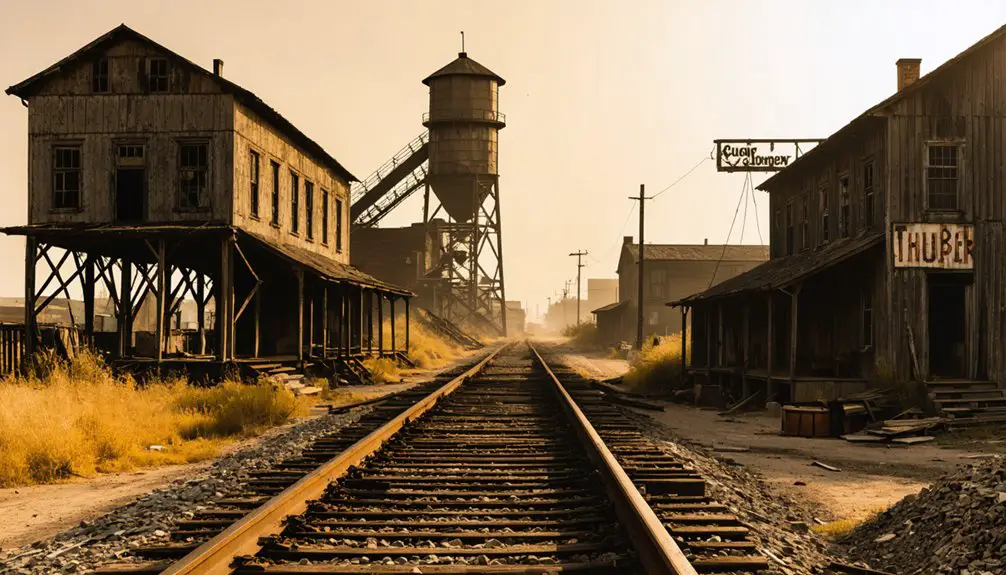
You’ll find that Texas’s burgeoning oil industry directly contributed to Chinese Coal Mine’s downfall, as petroleum increasingly displaced coal as the primary fuel source.
The shift from steam to diesel locomotives drastically reduced the demand for coal, particularly affecting mines like this one that supplied railroad fuel.
Higher labor costs combined with the mine’s poor-quality coal made continued operations economically unfeasible, forcing its closure and triggering the town’s exodus.
Oil Industry Dominance Emerges
As Texas emerged as America’s oil powerhouse in the early 20th century, its economic landscape underwent a dramatic shift that would reshape the state’s future.
You’re witnessing the results of that oil dominance today, with Texas producing 43% of America’s crude oil and generating over $27 billion in tax revenue.
This economic change didn’t just change the state’s finances – it revolutionized entire communities, as oil wealth drew people away from coal-dependent towns toward new opportunities in places like Midland and Longview.
- The Permian Basin and Eagle Ford Shale now contain a quarter of America’s largest oil fields
- Advanced drilling technology increased production efficiency by 21% year-over-year
- Texas built 465,025 miles of pipelines to support its growing oil empire
- Record-breaking tax revenues fund schools, infrastructure, and public services
Railroad Fuel Sources Shift
While steam locomotives once dominated American railways by burning coal, the transportation industry’s dramatic shift to diesel-electric engines after World War II sparked an exodus from coal-dependent communities.
This railroad evolution transformed the economic landscape of towns like Chinese Coal Mine. You’d have witnessed diesel engines steadily replacing coal-fired steam locomotives throughout the 1950s and 60s, as they offered better efficiency and lower operating costs.
The fuel change meant railroads no longer needed extensive coal supplies along their routes, devastating local mining operations. With diesel locomotives requiring less fuel-related infrastructure, the crucial connection between coal towns and railways began to crumble.
As natural gas and renewable energy sources gained prominence, you could see the final remnants of coal’s railroad legacy fade, leaving behind abandoned tracks and empty communities.
Labor Costs Drive Closures
Labor costs became a decisive factor in Chinese Coal Mine‘s decline during the late 1960s, when the town’s labor-intensive mining operations couldn’t keep pace with modernizing competitors.
You’d find nearly five times more workers per 10,000 tons of coal compared to efficient operations, driving costs unsustainably high. When labor costs hit 215 yuan per ton while competitors maintained costs below 200 yuan, mine closures became inevitable.
- Mechanized mines needed only 4-5 workers per 10,000 tons, while Chinese Coal Mine required 21
- Rising wages and outdated equipment created an impossible cost burden
- Safety upgrades and worker benefits further strained already tight margins
- Tax revenue plummeted as mines closed, accelerating the town’s economic spiral
The harsh reality of labor costs ultimately sealed the town’s fate, transforming it into another Texas ghost town.
Preserving Mining Town Heritage
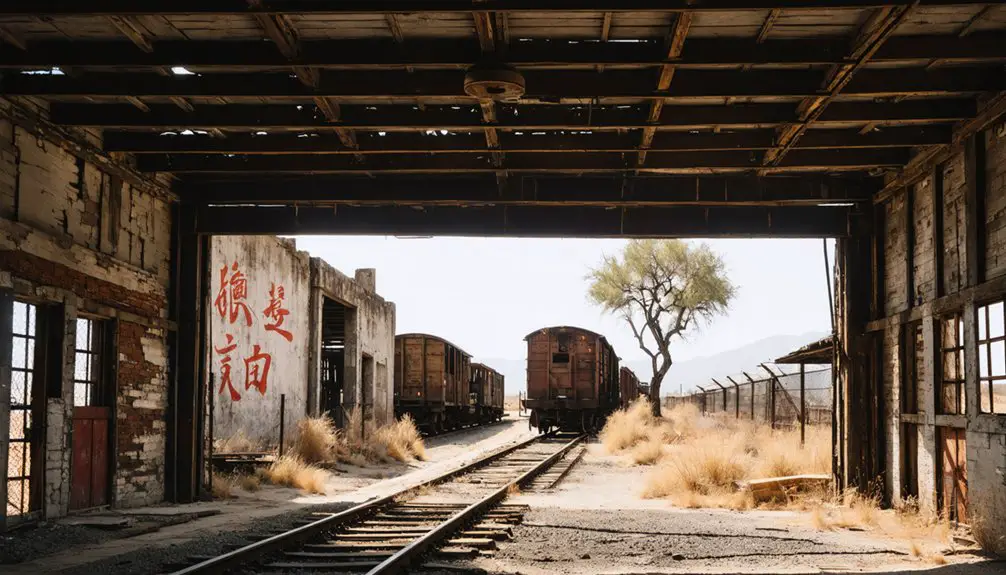
Despite the challenges of preserving mining town heritage, Texas has established extensive frameworks to protect these historic sites and their cultural legacy.
You’ll find the Texas Railroad Commission overseeing coal mine reclamation, ensuring lands return to their pre-mining state through monthly inspections and strict standards.
Heritage preservation efforts combine scientific restoration with community engagement. Local historical commissions document mining histories while preserving cemeteries and landmarks.
Local communities work hand-in-hand with preservation experts to protect mining sites, recording their stories and safeguarding historic places.
You can explore community gardens on reclaimed lands, like the Jewett Mine project that produces 10,000 pounds of food yearly for local pantries.
Educational programs and museum exhibits keep the mining legacy alive, while oral histories capture residents’ experiences for future generations.
Through public-private partnerships and local preservation laws, these towns maintain their identity despite economic challenges.
Ghost Stories and Local Legends
Deep within the Texas countryside, ghostly tales echo through the abandoned Chinese Coal Mine, named for the railroad workers who lost their lives during its construction in the late 1800s.
You’ll find gravesites of Chinese laborers on the northern hill, where locals report seeing ghostly apparitions near the old railroad tracks. The mine’s brief operational period and high-sulfur coal have contributed to stories of restless spirits, while spectral miners are said to watch from nearby hills before vanishing into the mine shaft.
- Mysterious sounds of pickaxes and dragging chains remind visitors of the site’s tragic past
- The isolated location on May Ranch intensifies the eerie atmosphere
- Ancient fossils and exposed graves blend natural history with supernatural elements
- The abandoned eight-mile railroad track symbolizes unfinished business of departed souls
Frequently Asked Questions
What Traditional Chinese Festivals Were Celebrated in Texas Mining Communities?
You’ll find Chinese miners celebrated five main festivals: Chinese New Year, Mid-Autumn Festival, Qingming Festival, Dragon Boat Festival, and the Lantern Festival marking New Year’s end.
Did Chinese Miners Intermarry With Other Ethnic Groups in These Towns?
Standing apart in isolated camps, you’d rarely find cultural exchange through marriage. Chinese miners didn’t typically intermarry, staying within their communities due to discrimination and limited social integration opportunities in Texas mining towns.
How Did Chinese Miners Communicate With English-Speaking Supervisors and Co-Workers?
You’ll find they relied on non-verbal gestures, basic phrases, and simplified English, while bilingual communication through interpreters was limited. Cultural exchange led to mutual adaptation of terms and customs over time.
Were There Any Chinese-Owned Businesses Operating Alongside the Company Stores?
Like seeds falling on barren soil, Chinese entrepreneurship couldn’t take root here. You won’t find evidence of Chinese-owned businesses – the company stores’ monopoly and discrimination prevented community support systems from developing.
What Happened to Chinese Cemeteries and Burial Grounds After Towns Were Abandoned?
You’ll find these sacred grounds suffered from neglect, with cemetery preservation largely failing as vegetation overtook markers. Many burial practices were forgotten, though some sites retain protective signs warning against trespassing or desecration.
References
- https://en.wikipedia.org/wiki/List_of_ghost_towns_in_Texas
- https://www.ghosttowns.com/states/tx/tx.html
- https://www.youtube.com/watch?v=phjUE19A8HM
- https://www.youtube.com/watch?v=n82okde31YY
- https://dallas.culturemap.com/news/travel/07-31-17-thurber-texas-coal-mine-ghost-town/
- https://www.themoonlitroad.com/ghost-town-thurber-texas/
- https://austin.culturemap.com/news/travel/08-07-17-thurber-texas-coal-mine-ghost-town/
- https://www.amysatticss.com/ghost-towns/
- https://www.novanumismatics.com/the-ghost-town-tokens-of-thurber-texas/
- https://www.hipcamp.com/journal/camping/texas-ghost-towns
